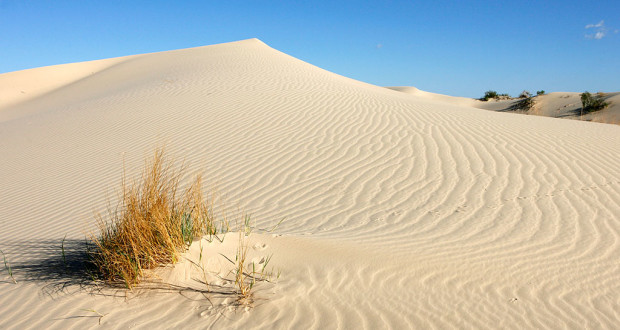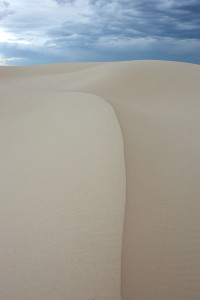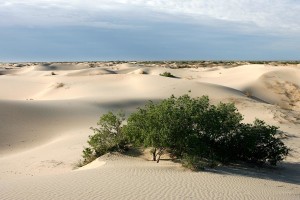Miles and miles of dry, sandy scrub surrounding the state park suddenly give way at its center to an expanse of ivory sand whipped into dunes rising more than six stories above the desert floor.
The park’s 3,840 acres are part of a larger dune field that runs for 200 miles along the edge of the Southern High Plains in West Texas. But while most of those dunes are anchored by shin oaks and other scrubby vegetation, the park’s barren dunes make you feel as if you’ve just stepped into the Sahara Desert.
The bare sand advances in dry years, consuming the surrounding vegetation, but retreats again with heavier rainfall. Although the dunes appear ephemeral in the shifting winds, the sand that built them began accumulating here tens of thousands of years ago, when ancient camels walked the landscape. Carried by water from the eroding Southern Rockies, the sand slowly accumulated in the Pecos River floodplain, where the relentless winds of West Texas took hold.
There are no trails to speak of, but you can reach the dunes from the end of most of the park’s short loops. A windmill near the parking lot provides a good point of reference to lead you back home.
One strategy for walking the dunes is to climb to a high point and survey the landscape, where you’ll see a pattern of long, parallel dune crests that you can follow, rather than repeatedly climbing up and down the slopes. Some are flattened and more stable, while the tallest sometimes have sharp crests that require you to straddle the unstable slopes on either side. A stiff gust of wind blows sand off the dune crests like sugar brushed off a table.
To avoid the “sand surfers” on their toboggans, hike in the cool of the morning when the early light and shadows reveal the contours of the dunes and patterns etched in the sand. By moonlight, the landscape appears blanketed by a fresh fall of snow.
Dunes begin to form when rock, vegetation or other obstacles slow down the wind and cause it to drop its load of suspended sand, much as a river drops sand and silt as its current slows. On the windward side of the developing dune a long, low slope of sand builds up to a crest and then tumbles down a steeper slope on the leeward side. When the angle gets too steep, minor avalanches restore its stability. The flow of sand blowing up the near side and falling off the far side in time builds dunes as tall as 80 feet.
It takes a wind speed of about 14 mph to set the sand in motion. As it falls to the ground, it tends to bounce and knock other, heavier grains about, creating the familiar ripples that squiggle into the distance.
While dunes move about from season to season with shifting wind patterns, over years’ time they tend to remain in about the same place.
Deserts always look a little sterile from a distance but come alive the closer you get. Before the wind kicks up in the morning, look closely in the sand for the delicate tracks and burrows of beetles, birds, lizards and scurrying mammals – a temporary record of the previous night’s activity.
Surprisingly, fresh water often lies not far below the dunes and can emerge in temporary pools or “seeps” between them after a rain, often marked by small oases of vegetation. They vary from isolated clumps of grass to terraces landscaped with shin oaks and shrubs. The locals call the shin oak the “upside down tree”. It rarely grows more than 3 feet tall but its extensive roots reach down as much as 70 feet into the sand below. Outside of the barren dunes, the park transitions to a dense shin oak forest.
PARK GALLERY










